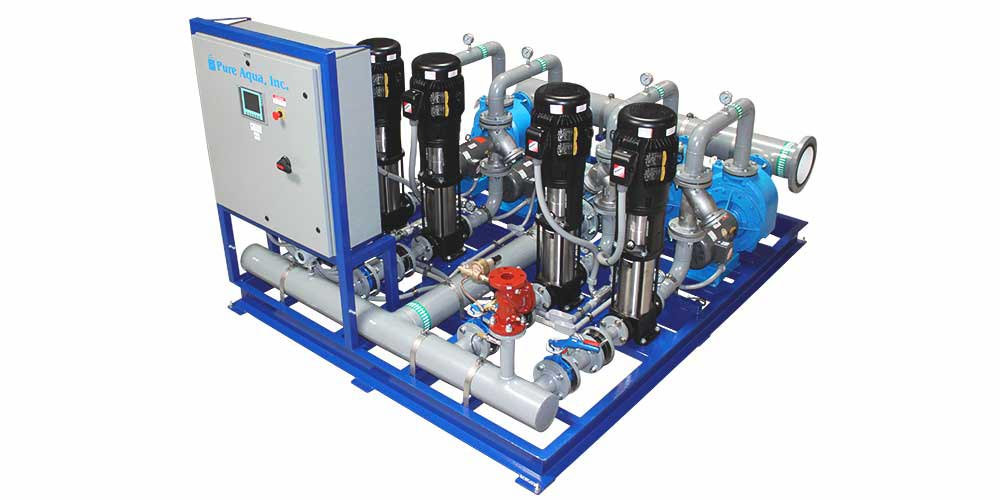Reverse osmosis (RO) is a filtration method that removes many types of large molecules and ions from solutions by applying pressure to the solution when it is on one side of a selective membrane. The result is that the solute is retained on the pressurized side of the membrane and the pure solvent is allowed to pass to the other side. To be "selective," this membrane should not allow large molecules or ions through the pores (holes), but should allow smaller components of the solution (such as the solvent) to pass freely.
That being said, it is vital to the preservation of the quality of your reverse osmosis membrane to pre-treat any materials that could harm reduce the effectiveness of the membrane itself. These materials may simply cause damage over time, or some may destroy a membrane outright.
Reverse Osmosis
Reverse Osmosis is most commonly known for its use in drinking water purification from seawater, removing the salt and other substances from the water molecules. This is the reverse of the normal osmosis process, in which the solvent naturally moves from an area of low solute concentration, through a membrane, to an area of high solute concentration. The movement of a pure solvent to equalize solute concentrations on each side of a membrane generates a pressure and this is the "osmotic pressure." Applying an external pressure to reverse the natural flow of pure solvent, thus, is reverse osmosis.
The process is similar to membrane filtration. However, there are key differences between reverse osmosis and filtration. The predominant removal mechanism in membrane filtration is straining, or size exclusion, so the process can theoretically achieve perfect exclusion of particles regardless of operational parameters such as influent pressure and concentration. Reverse osmosis, however involves a diffusive mechanism so that separation efficiency is dependent on solute concentration, pressure and water flux rate.

Pretreatment
Pretreatment is important when working with RO and nanofiltration (NF) membranes due to the nature of their spiral wound design. The material is engineered in such a fashion as to allow only one-way flow through the system. As such, the spiral wound design does not allow for back pulsing with water or air agitation to scour its surface and remove solids. Since accumulated material cannot be removed from the membrane surface systems, they are highly susceptible to fouling (loss of production capacity). Therefore, pretreatment is a necessity for any RO or NF system.
Pretreatment in SWRO systems has four major components:
- Screening of solids: Solids within the water must be removed and the water treated to prevent fouling of the membranes by fine particle or biological growth, and reduce the risk of damage to high-pressure pump components.
- Cartridge filtration: Generally, string-wound polypropylene filters are used to remove particles between 3 - 5 microns.
- Dosing: Oxidizing biocides, such as chlorine, are added to kill bacteria, followed by bisulfite dosing to deactivate the chlorine, which can destroy a thin-film composite membrane. There are also biofouling inhibitors, which do not kill bacteria, but simply prevent them from growing slime on the membrane surface.
- Prefiltration pH adjustment: If the pH, hardness and the alkalinity in the feedwater result in a scaling tendency when they are concentrated in the reject stream, acid is dosed to maintain carbonates in their soluble carbonic acid form.
CO3-2 + H3O+ = HCO3- + H2O
HCO3- + H3O+ = H2CO3 + H2O
- Carbonic acid cannot combine with calcium to form calcium carbonate scale. Calcium carbonate scaling tendency is estimated using the Langelier saturation index. Adding too much sulfuric acid to control carbonate scales may result in calcium sulfate, barium sulfate or strontium sulfate scale formation on the RO membrane.
- Prefiltration antiscalants:Scale inhibitors (also known as antiscalants) prevent formation of all scales compared to acid, which can only prevent formation of calcium carbonate and calcium phosphate scales. In addition to inhibiting carbonate and phosphate scales, antiscalants inhibit sulfate and fluoride scales, disperse colloids and metal oxides, and specialty products can be to inhibit silica formation.
[/custom-specifications]
| Pure Aqua offers a wide range of pre treatment such as: | ||
|
|
|
[/custom-features]
Applications:
- Drinking Water Treatment
- High Purity Water
- Industrial Process Water
- Water Recycle and Reuse
Here at Pure Aqua, Inc., we engineer and build all of our water treatment systems in-house.
Our turn-key water treatment systems are all pre-engineered using the latest CAD technology available.
This enables our teams to build and deliver treatment systems to our customers with quick turnaround times.
Many of our customers require custom engineered systems. These are typically built around similar core systems and thus allowing for improved turnaround times, even for one-off designs.
-
Good service
Remarkably neat packaging
-
Fast to send
Fast shipping
- 360view:
- https://cdn11.bigcommerce.com/s-1x0ys7yqwf/content/360Views/Coming%20Soon.0.html
- 360image:
- https://cdn11.bigcommerce.com/s-1x0ys7yqwf/product_images/uploaded_images/360view-wireframe-small.jpg
 ENGLISH
ENGLISH ESPAÑOL
ESPAÑOL العربية
العربية PORTUGUÉS
PORTUGUÉS FRANÇAIS
FRANÇAIS














